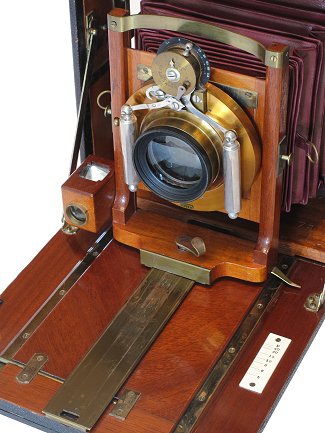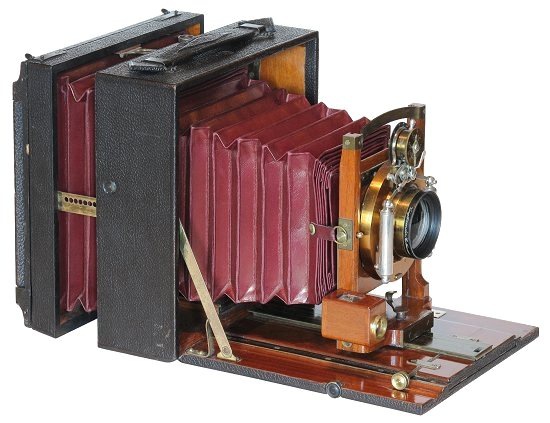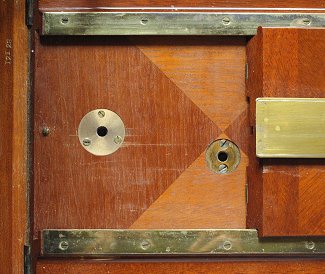|
|





Copyright ©2009 by Rob Niederman - ALL RIGHTS RESERVED
Return to the Self-Casing Cameras page
Regardless of the number of self-casing cameras made and sold
in the 1890s, new models continued to flood the market. Even as
the 20th Century quickly approached and rollfilm continued to grow in
popularity, variations of these fine portable cameras flowed into the
eager hands of amateur photographers: Full-featured & expensive to
entry-level & inexpensive.
Some, such as the Korona Special, represented the high point of artistic expression. Yet nearly all were variations on the basic red-bellows folder theme.
The camera shown here is a puzzle. Its extraordinary craftsmanship is more functional than artistic, yet not quite as sophisticated as solidly built the Henry Clay Camera.
Materials are first rate: Finely pebbled body leather, strong red bellows, robust brass hardware, and furniture quality wooden interior make this an unusual camera.
Some, such as the Korona Special, represented the high point of artistic expression. Yet nearly all were variations on the basic red-bellows folder theme.
The camera shown here is a puzzle. Its extraordinary craftsmanship is more functional than artistic, yet not quite as sophisticated as solidly built the Henry Clay Camera.
Materials are first rate: Finely pebbled body leather, strong red bellows, robust brass hardware, and furniture quality wooden interior make this an unusual camera.
Multi-Lens Cameras | View Cameras | Self-Casing Cameras | Solid Body Cameras | References & Advertisements
Home | What's New | Show Schedule | Wanted | For Sale | Links | Site Map | Email
Home | What's New | Show Schedule | Wanted | For Sale | Links | Site Map | Email
American Self-Casing Camera, c.1899
Unidentified Maker
Unidentified Maker
Take a close look. What do you see? Gennert's bright reflex finder. Outer body leather, reversible back, and wooden front standard inspired by the
Poco and Premo cameras of Rochester Optical. A rear viewing door using Scovill's Henry Clay Regular hinged struts. Huge German glass mounted on
a Bausch & Lomb diaphragm shutter. Ideas and bits of construction borrowed from several leading builders. Then there are the unique details and
features not found in any maker's catalogue such as an innovative brass rear extension with full swings and tilts. Unusually heavy arched, brass
bridge connecting the front-standard uprights.
American self-casing camera, 5 x 7 inch format. Impeccable
construction. Shutter mounted with Voigtlaender Collinear II lens.
And finally the drop bed. On the surface, it looks like a typical triple extension design. Look closer
and admire the stunning inset polished wood panels cut at 45 degree angles.
Now Dig deeper. Hidden beneath the wooden extension bed and leather body covering are four panels in a diamond pattern; an expensive yet elegant construction treasure adding strength and warp resistance. Two tripod mounts placed at different balance points further ensure that the bed remains intact.
Now Dig deeper. Hidden beneath the wooden extension bed and leather body covering are four panels in a diamond pattern; an expensive yet elegant construction treasure adding strength and warp resistance. Two tripod mounts placed at different balance points further ensure that the bed remains intact.
Questions ... and more questions ...
Which factory produced this camera and what model name was intended for the blank brass plaque?
Why all the subtle attention to detail?
What can be learned from build-lot number 72 and serial number 121 28?
Even after careful examination and exhaustive research, I still don't know the answers. Maybe someone else does; feel free to contact me.
Which factory produced this camera and what model name was intended for the blank brass plaque?
Why all the subtle attention to detail?
What can be learned from build-lot number 72 and serial number 121 28?
Even after careful examination and exhaustive research, I still don't know the answers. Maybe someone else does; feel free to contact me.